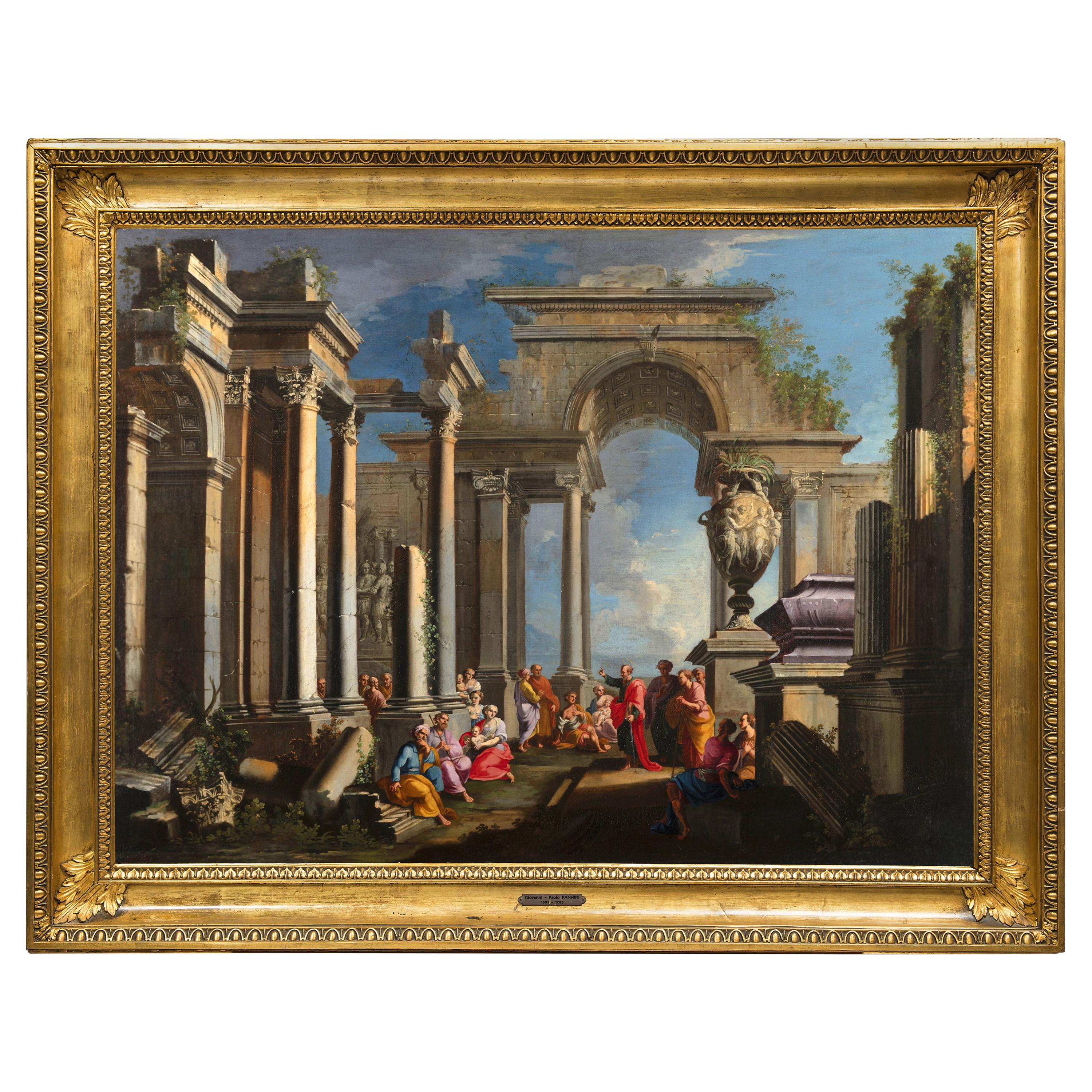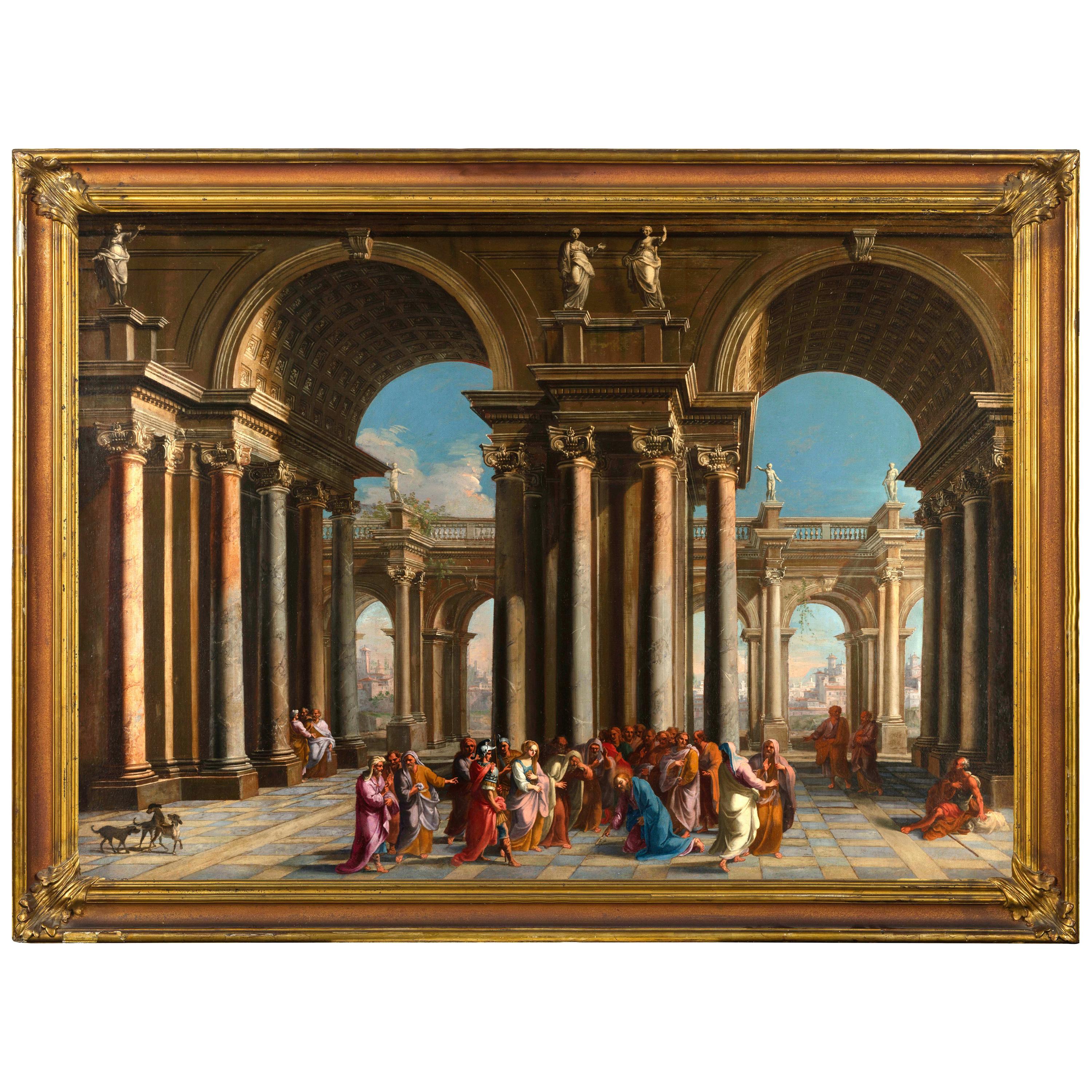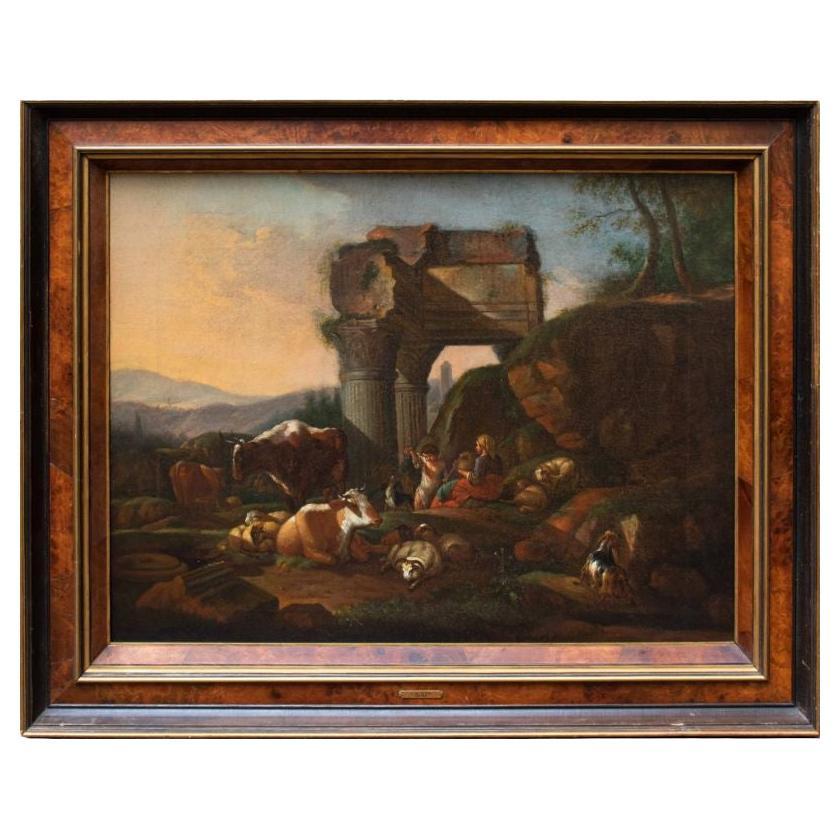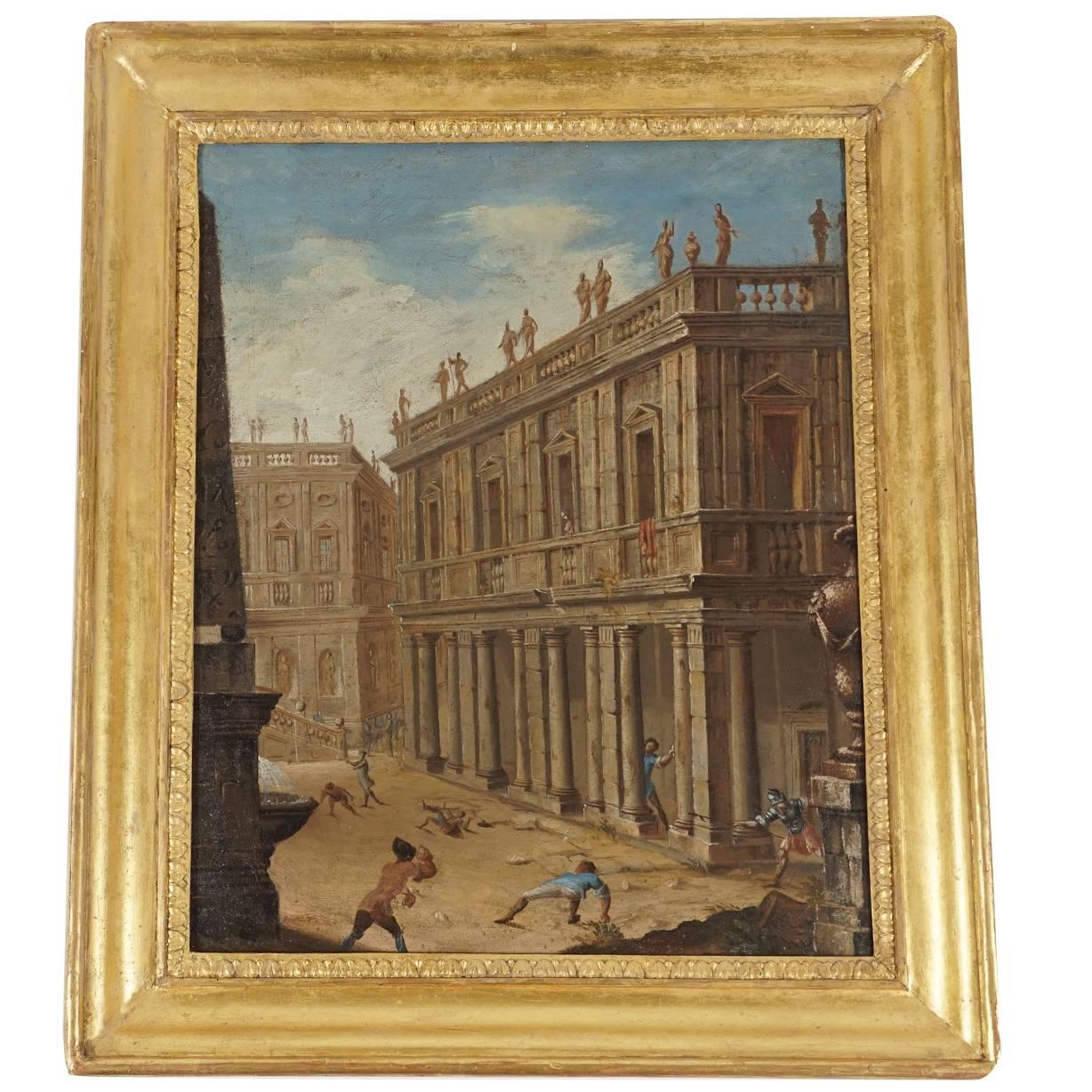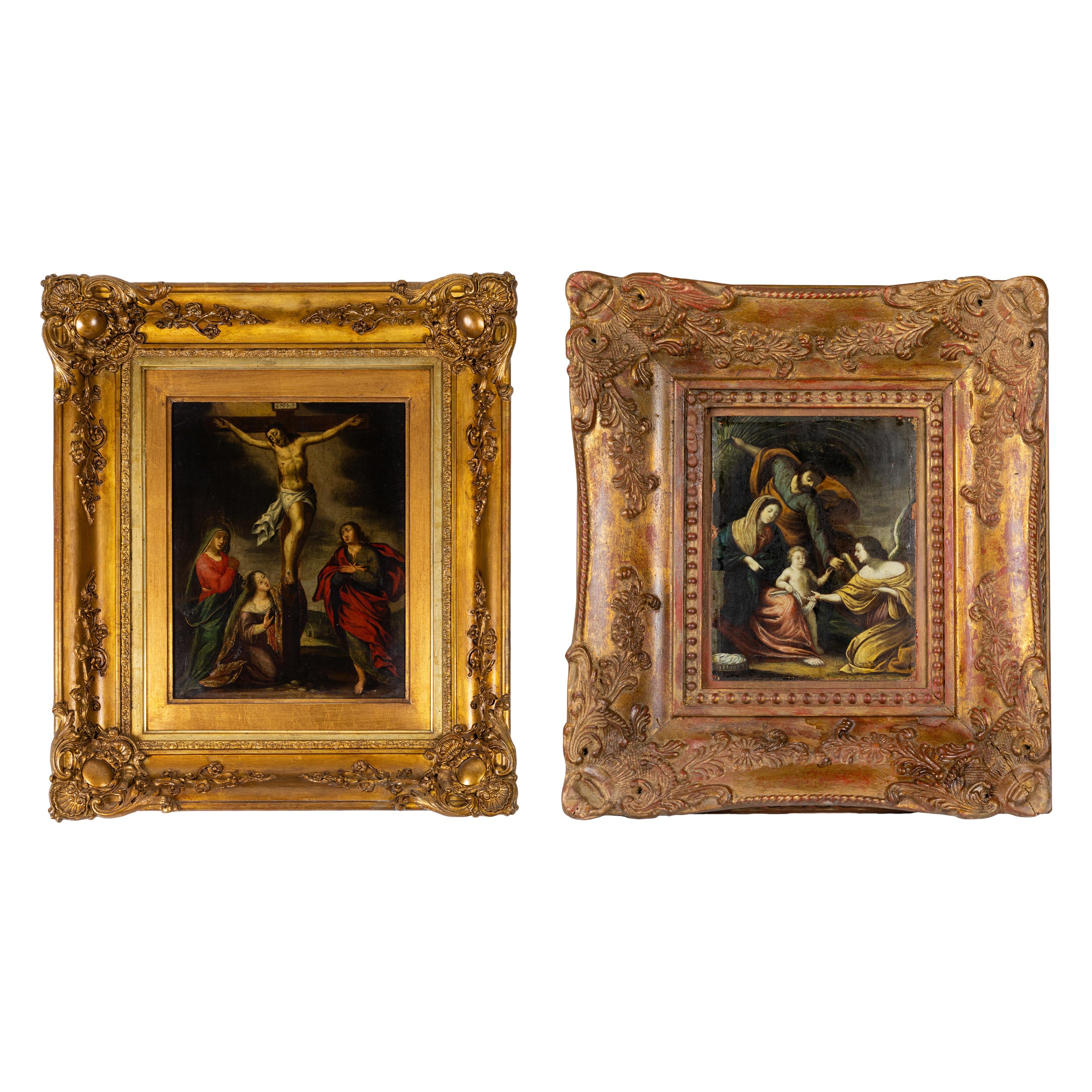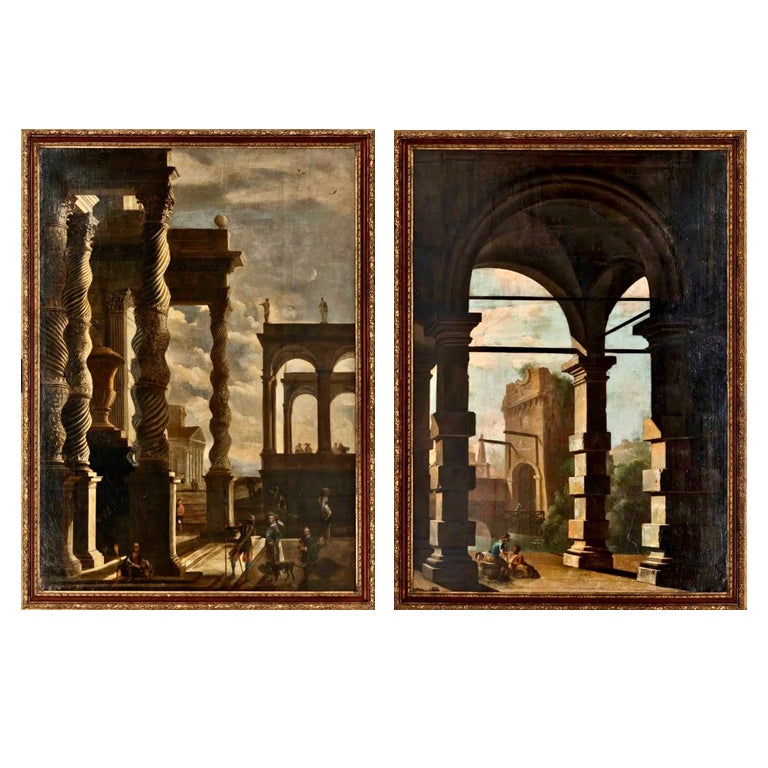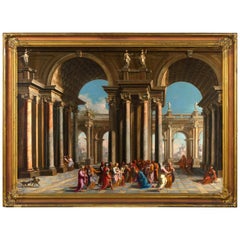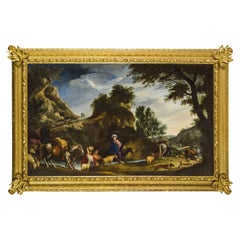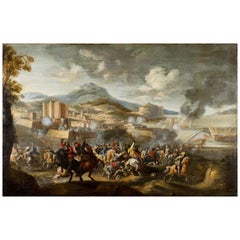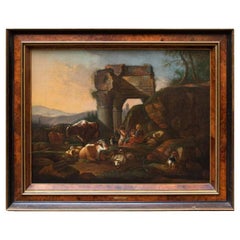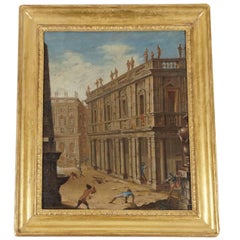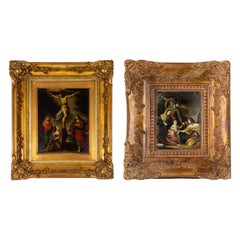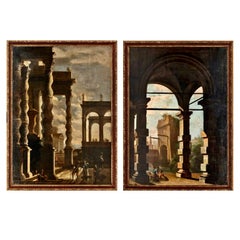Items Similar to 17th Century, Pair Italian Paintings Architectural Capriccio by Alberto Carlieri
Want more images or videos?
Request additional images or videos from the seller
1 of 21
17th Century, Pair Italian Paintings Architectural Capriccio by Alberto Carlieri
About the Item
17th century, Pair of paintings depicting Architectural Caprices with Bacchanal and Sacrifice Scene, Alberto Carlieri (Rome 1672-1720)
Oil on canvas; Dimensions: canvas cm H 73.5 x W 97. Frame: cm W 118.5 x H 94.5 x D 5
Previously in Rome, Galleria Lampronti
This fine pair of paintings, created in oil on canvas and presented in carved and gilded wooden frames in style, depict architectural caprices enlivened by figures and scenes with a classical taste. The works, attributed to Alberto Carlieri, are published in Giancarlo Sestieri's book Il Capriccio Architettonico.
The canvases are titled as follows:
Bacchanal with Bacchus on an Ass, Dancing Young Women and Musicians, Amorini with Flowers.
Courtyard of a Ionic Palace with Upper Cornice in Ruins, Statues, and Vases. On the right, a large amphora-shaped vase sculpted in bas-relief.
Sacrifice Scene in the Atrium of a Composite Palace. Front Arch and Niches with Female Allegorical Statues Between the Arches.
The works, painted with great finesse, even in the details and small figures, clearly express the artistic style of the famous Roman painter Alberto Carlieri (Rome, 1672 - 1720), the most appreciated and sought-after artist in Rome between the death of Giovanni Ghisolfi (Milan 1623-1683) and the rise of Giovanni Paolo Panini (Piacenza 1691 – Rome 1765).
Carlieri was born in Rome in 1672 and began studying architectural painting under the guidance of Giuseppe de Marchis. He later became a student and collaborator of Andrea Pozzo. Present in the most illustrious Roman collections, including those of Filippo II Colonna, the Rospigliosi family, and Cardinal Valenti Gonzaga, Carlieri developed well-recognized compositional models influenced not only by his master’s work but also by those of Viviano and Nicolò Codazzi. His artistic career can be traced through signed works, around which a fairly extensive catalogue of canvases has been built. Information about Carlieri and his signed or dated works spans between 1690 and around 1720. Nothing specific is known about the painter's life, but he is believed to have died in Rome shortly after 1720.
The works are in excellent condition and feature modern relining.
High-resolution images are available upon request.
Bibliography: Il Capriccio Architettonico in Italia nel XVII e XVIII secolo, by Giancarlo Sestieri, EtGraphiae, 2015, p. 198
- Attributed to:Alberto Carlieri (Painter)
- Dimensions:Height: 37.41 in (95 cm)Width: 46.86 in (119 cm)Depth: 1.97 in (5 cm)
- Style:Baroque (Of the Period)
- Materials and Techniques:
- Place of Origin:
- Period:Late 17th Century
- Date of Manufacture:Late 17th Century
- Condition:Wear consistent with age and use. The works are in excellent condition and feature modern relining.
- Seller Location:IT
- Reference Number:1stDibs: LU4405242603452
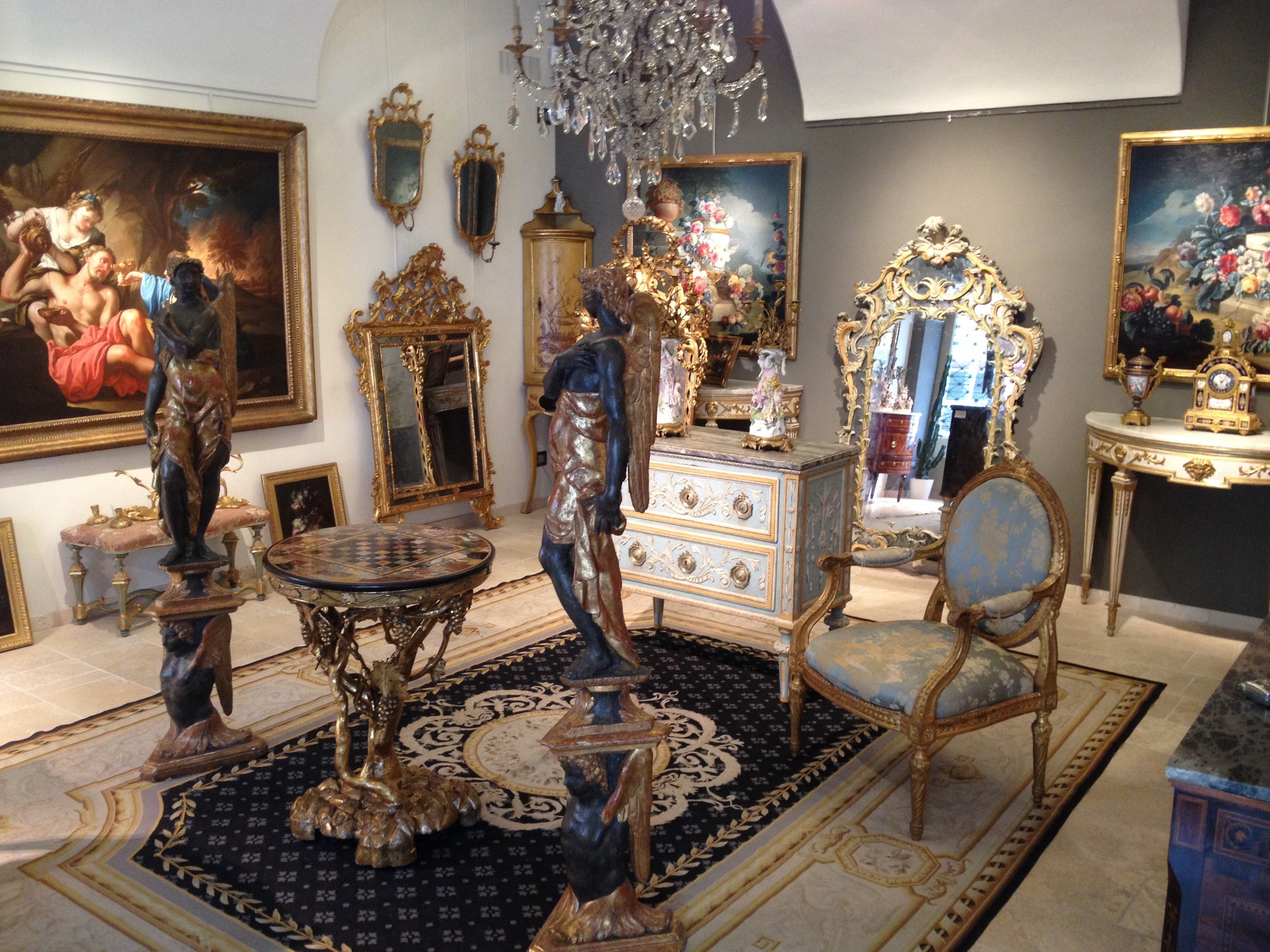
About the Seller
5.0
Platinum Seller
Premium sellers with a 4.7+ rating and 24-hour response times
Established in 1980
1stDibs seller since 2019
54 sales on 1stDibs
Typical response time: <1 hour
- ShippingRetrieving quote...Shipping from: Italy
- Return Policy
Authenticity Guarantee
In the unlikely event there’s an issue with an item’s authenticity, contact us within 1 year for a full refund. DetailsMoney-Back Guarantee
If your item is not as described, is damaged in transit, or does not arrive, contact us within 7 days for a full refund. Details24-Hour Cancellation
You have a 24-hour grace period in which to reconsider your purchase, with no questions asked.Vetted Professional Sellers
Our world-class sellers must adhere to strict standards for service and quality, maintaining the integrity of our listings.Price-Match Guarantee
If you find that a seller listed the same item for a lower price elsewhere, we’ll match it.Trusted Global Delivery
Our best-in-class carrier network provides specialized shipping options worldwide, including custom delivery.More From This Seller
View AllAlberto Carlieri, Painting with Architectural Capriccio
By Alberto Carlieri
Located in IT
Alberto Carlieri (Rome 1672-1720)
"Architectural capriccio with the preaching of Saint Paul in the Areopagus of Athens"
Oil on canvas, measures with...
Category
Antique Late 17th Century European Baroque Paintings
Materials
Canvas
$70,500 Sale Price
20% Off
Alberto Carlieri, Capriccio with Christ and the Adulteress, Oil on Canvas
By Alberto Carlieri
Located in IT
Alberto Carlieri (Italy-Roma 1672-1720), "Christ and the adulteress",
Oil on canvas, with frame cm H 115 x L 151 x 6.5, only canvas H 98.5 x L 135 cm...
Category
Antique Late 17th Century Italian Baroque Paintings
Materials
Canvas
$70,500 Sale Price
20% Off
17th Century, Italian Painting by Pier Francesco Cittadini, Jacob and his Family
Located in IT
Pier Francesco Cittadini (Milan, 1616-Bologna, 1681)
"Jacob and his family go to Egypt"
Oil on canvas, cm 109 x 190 (canvas only)
The valuable painting, made in oil on canvas, depicts Jacob and his family go to Egypt and we believe it can be, given the high quality painting, autograph work of Italian Pier Francesco Cittadini (Italy Milan, 1616 - Bologna, 1681) made after 1647. The work, in excellent condition is accompanied by a coeval frame in wood finely carved and golden.
The scene depicted, which was confused with the Flight to Egypt in the past years, is instead identified with the biblical episode of Jacob’s journey. In the foreground, reading the painting from left to right, we see a caravan composed of animals, including donkeys, dromedaries, goats, dogs and horses and people, women, men and slaves, who carry on their journey along the banks of a river, following a path that to the right, would seem to lead to the through of a bridge. In addition to the watercourse is described an environment characterized by large rocks and impervious come far to cover the entire verticality of the canvas. On the left, in the distance, we see the tail of the caravan that runs along the steep path. Large trees enliven and harmonize the environment, as well as white and grey clouds characterize the predominantly clear sky and illuminated on the right by sunlight.
The story is told in the Bible, Book of Genesis, 30, 25, passage in which is described the flight of Jacob from Haran after the contrasts with Laban, father of his wife Rachel. Jacob is the third great patriarch of the Bible. From his descendants originate the twelve generations of the people of Israel. He is the son of Isaac and Rebekah, who led him to flee from the wrath of Esau to Haran to seek refuge from his brother, Laban. At his uncle’s house Jacob met his daughter Rachel. As soon as he saw his cousin, Jacob was taken. Jacob will stay seven years in the service of Laban to marry his beloved Rachel. But Laban, with a deception, will give him in marriage first Lia, the least beautiful eldest daughter, and only after another seven years the splendid Rachel. From his first wife he will have several children, while Rachel will give birth to the beloved son, Joseph, who will become viceroy of Egypt.
After years of service, Jacob asked to be paid with every dark-coloured garment among the sheep and every spotted and dotted garment among the goats. Laban accepted and sent away from his sons all the leaders of that kind. So Jacob took fresh branches of poplar, almond and plane tree, and flayed them, and put them in the troughs. The optical suggestion induced the goats and the sheep to conceive and give birth to dark, striped and dotted garments. He also ensured that all the strongest and healthiest leaders of the flock of Laban would drink near the barked branches, thus assuring a genetic superiority to his part of the flock. His flocks grew numerous and strong and he became richer than his relative, arousing envy. It was clear that Laban would not respect him much longer. At the suggestion of the Lord, Jacob decided to return to Canaan. Trying to avoid any possible dispute, he left with his family while Laban was absent for shearing sheep. But when, three days later, his uncle returned home, he became angry, feeling offended because Jacob had gone secretly and had not allowed him to greet his daughters and grandchildren. In addition, his teraphim, statuettes, or idols, which depicted the family deities, had disappeared. After 7 days of pursuit, Laban and his men reached Jacob’s group on Mount Gilead, in the mountainous region west of the Euphrates River, where his uncle and grandson had a stormy conversation. The younger man was outraged at being accused of stealing idols and told Labano to rummage through his family’s tents at will. Neither of them could know or even imagine that it was Rachel who took the idols and hid them in the saddle of the camel. During the search, she sat down firmly on the saddle, apologizing for not being able to get up, «because I usually have what happens to women» (Gen 31:35). So the loot wasn’t discovered.
The author of this work was inspired by the composition of an engraving by Stefano Della Bella (1610-1664) of circa 1647. The engraving by Stefano della Bella bears the title "Iacob sur ses vieux jours quitte sans fascherie pour voir son filz Ioseph, sa terre et sa patrie" and is signed on the bottom left "Stef. of the Beautiful In. et fe." while on the right it is declared "Cum privil. Regis", that is with license of the king.
Stefano Della Bella (Italy - Florence, May 18, 1610-Florence, July 12, 1664) was born in a family of painters, sculptors and goldsmiths and was left early orphan of his father sculptor, he dedicated himself first to the art of goldsmith at the school of Giovanni Benedetto Castiglione and Gasparo Mola, then turning his attention to drawing and engraving. He soon began drawing figures and copying the etchings of Jacques Callot, which inspired his early works. Under the protection of the Medici, in particular of Don Lorenzo, cadet son of Grand Duke Ferdinand I, Della Bella has the opportunity to make study trips to Rome, where he stayed from 1633-1636; In Rome he met French engravers and publishers of prints such as Israël Henriet and François Langlois, who influenced his decision to move to Paris in 1639, four years after the death of Callot. In Paris he soon reached, thanks to the engravings commissioned by Cardinal Richelieu, the success also worldly; he frequented courtiers, theatre artists and writers, while refusing too oppressive honors. In 1646-1647 he continued his travels in the Netherlands to Amsterdam, Antwerp and Dordrecht. He returned to Florence in 1650 and resumed working under the protection of the Medici court, working for his patrons. In 1656 he became a member of the Academy of Apatists.
The painting object of this study is reasonably attributable to Pier Francesco Cittadini, or Pierfrancesco Cittadini, called the Milanese or the Franceschino (Italy - Milan, 1616-Bologna, 1681) as some exemplary stylistic comparisons proposed to follow can prove.
Pier Francesco Cittadini was an Italian baroque painter, mainly active in Bologna.
His artistic training first took place with the painter Daniele Crespi...
Category
Antique Mid-17th Century European Baroque Paintings
Materials
Canvas, Giltwood
$35,720 Sale Price
32% Off
17th Century, Italian Painting with Battle attributed to Marzio Masturzo
Located in IT
Marzio Masturzo, attributed (Active in Italy - in Naples and Rome- in the second half of the 17th century)
"Battle between cavalry and vessels with fortified city on the left"
...
Category
Antique Late 17th Century Italian Baroque Paintings
Materials
Canvas
$39,656 Sale Price
25% Off
17th Century, Italian Painting with Virgin and Child by Follower of Van Dyck
By Anthony van Dyck
Located in IT
17th century, Italian painting with virgin and childr by Follower of Sir Anthony van Dyck
cm W 90 x H 113; cornice cm W 111 x H 135 x D 7
The canvas depicts the Madonna with the Chi...
Category
Antique Late 17th Century Italian Baroque Paintings
Materials
Canvas
17th Century, Italian Painting Saint Jerome Hears the Trumpet of Judgment
Located in IT
Saint Jerome Hears the Trumpet of Judgment, Neapolitan School, 17th Century
This exquisite oil-on-canvas painting depicts Saint Jerome hearing the trumpet of the angel of the Last Ju...
Category
Antique 17th Century Italian Baroque Paintings
Materials
Canvas
You May Also Like
17th Century Architectural Capriccio with Herds Painting Oil on Canvas
Located in Milan, IT
Circle of Nicolaes Berchem (1620, Haarlem - 1683, Amsterdam)
Architectural capriccio with herds
Oil on canvas, 57.5 x 74 cm
With frame 76 x 93 cm
The examined canvas is...
Category
Antique 17th Century Dutch Paintings
Materials
Canvas
Circle of Alessandro Salucci, 17th Century Italian Oil on Canvas 'Capriccio'
By Alessandro Salucci
Located in Kinderhook, NY
17th-century Italian Baroque oil on canvas 'capriccio' painting in the manner of Alessandro Salucci depicting an urban battle scene between what appear to be Spanish soldiers...
Category
Antique 17th Century Italian Baroque Paintings
Materials
Paint
$6,419 Sale Price
34% Off
Pair Of Baroque Paintings Of Christ, 17th Century, Italy
Located in Lisbon, PT
A pair of Italian baroque paintings of Jesus Christ:
- An 18th Century painting that depicts the Holy Family, Child Jesus, the Virgin Mary and the elderly Saint Joseph, with the An...
Category
Antique 17th Century Italian Baroque Paintings
Materials
Copper
Pair of Large 17th Century Italian Capriccios of Ruins Follower of Codazzi
By Viviano Codazzi
Located in Essex, MA
Pair of grand scale oil on canvas Capriccios by a Follower of Viviano Codazzi. Mid to late 17th century of ruins and figures. Neoclassical landscape. Beautifully imagined arches with...
Category
Antique Late 17th Century Italian Neoclassical Paintings
Materials
Paint
17th Century Onorio Marinari Italian Religious Painting
By Onorio Marinari
Located in Roma, IT
A very important painting by the great artist of the Florentine school, Onorio Marinari.
Dr. Silvia Benassai has confirmed Marinari’s authorship of the Saint Margaret of Antioch; available on demand, a historical-artistic fact sheet prepared by Dr. Silvia Benassai
Onorio Marinari (1627 – 5 January 1715) was a very important Italian painter and printmaker of the Baroque period, active mainly in Florence.
His father, Sigismondo di Pietro Marinari, was also a painter, and he trained with his cousin, Carlo Dolci, later being also influenced by Simone Pignoni and Francesco Furini.
His fresco in the Palazzo Capponi, Florence, is dated 1707. He worked mainly in Florence for Florentine and Tuscan clients, but he did not devote himself only to painting.
In fact, in 1674, he published an essay on astronomy entitled Fabbrica ed uso dell' Annulo Astronomico. Bartolomeo Bimbi was one of his pupils.
St. Margaret of Antioch
July 20, Martyr
Margaret, known as Margaret of Antioch in the West, and as Saint Marina...
Category
Antique Mid-17th Century Italian Baroque Paintings
Materials
Canvas, Wood
Madonna With Child Italian Painting Late 17th Century
Located in Milano, MI
Madonna and Child late 1600s, oil painting on canvas from northern Italy, in good condition, within walnut frame, from a private collection in Milan. The work depicts the Virgin hol...
Category
Antique Late 17th Century Italian Baroque Paintings
Materials
Canvas, Nutwood
